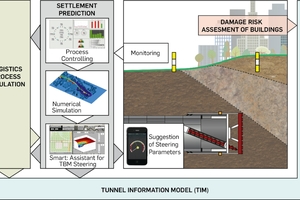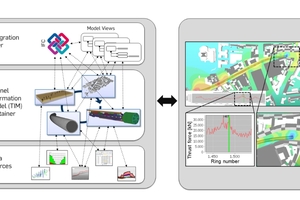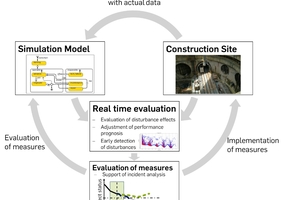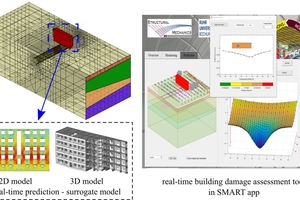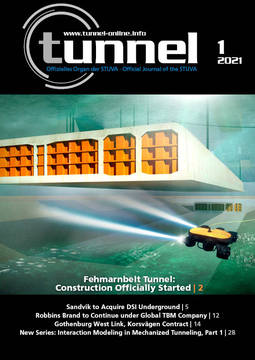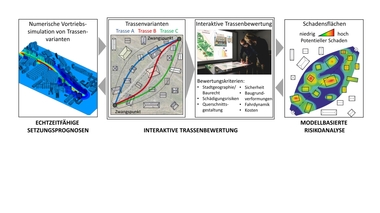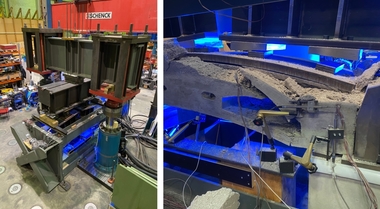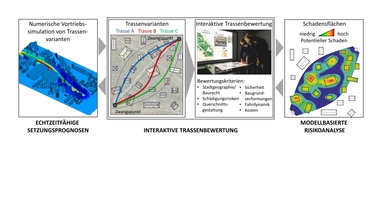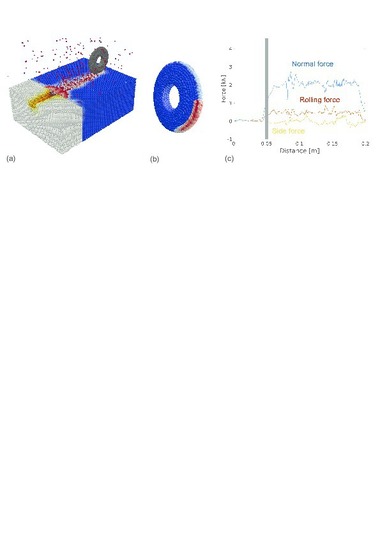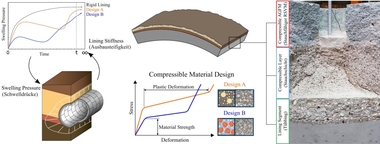Real-Time Simulations for Process Steering Support
Real-time simulations can help to support the steering of tunnel boring machines during tunnel construction. This requires setting up predictive simulation models during the initial planning phase of a tunnel project, which are continuously updated with monitoring data during the construction. In this contribution, models for real-time predictions of logistics processes and tunnelling induced settlements and the risk of building damage are presented, which allow optimizing the construction process.
1 Introduction
The German Research Foundation (DFG) established the Collaborative Research Center “Interaction Modeling in Mechanized Tunneling” (SFB 837) at Ruhr University Bochum in 2010. Collaborative Research Centers are interdisciplinary scientific research groups, in which cooperative research is conducted within the framework of a central research topic. The SFB 837 is currently the largest research group conducting fundamental research in tunnelling-related topics worldwide. The research goals of the SFB 837 are concerned with various relevant planning and construction aspects of the many components of the mechanized tunnelling process.
Selected results of research performed in the SFB 837 with a focus on the transfer potential to tunnelling engineering will be presented in a series of short articles in tunnel. This first contribution is related to real-time simulations for the support of the steering of TBMs during construction. Forthcoming articles will be focused on novel lining designs, advance exploration methods and monitoring, soil excavation and tool wear, face support, soil conditioning, material transport in hydro and EPB shield machines and interactive tunnel track design.
2 Real-Time Simulations in Mechanized Tunnelling
Real-time simulations allow, as an additional tool to usual monitoring campaigns, to effectively support controling and steering tunnelling construction processes. This includes construction logistics as well as tunnelling induced risks for the built environment. The concept of real-time simulations for Computational Steering requires to set up predictive simulation models in the design stage of a tunnelling project, which are continuously updated with monitoring data during the construction process, see Fig. 1. This allows to investigate different scenarios of the TBM operational parameters for subsequent excavation steps and can assist the engineers to make informed decisions aiming to optimize the construction process.
An important pre-requisite for real-time simulations is that all data are available in a continuously updated data base. An integrated tunnelling information platform has been developed for data management in tunnelling projects to support such simulations (Fig. 2, left). The platform implements a multi-model approach to link different data and models into a holistic Building Information Model (BIM) for tunnelling projects [1], here referred to as the Tunnel Information Model (TIM). The considered models are structured in different domains, such as models for the tunnel structure, the tunnel boring machine (TBM), the built environment and geological data, like boreholes and derived ground models. The consideration of further data sources depends on the applied use case, e.g. integrating settlement measurements and monitoring data to combine them into a 4D time-dependent settlement analysis (Fig. 2, right, [1]) or to compare them to real time simulations [2]. For such applications, also so-called link models are created to represent model interrelations in a non-transient and sustainable manner. Another aspect is the development of Model View Definitions (MVDs). On the one hand they allow the filtering of a specific model to only provide necessary content to a subsequent process, such as real-time simulation. On the other hand, MVDs are also used to ensure exchange requirements, such as the availability and formats of specific entities and related properties.
3 Logistics and Production Processes Simulation
To improve the planning of logistics processes in mechanized tunnelling, process simulation models were developed. The simulation models display the processes of a tunnelling project and their dependencies, considering uncertain boundary conditions, such as geological aspects. These models allow a detailed analysis of the performance of a mechanized tunnelling project and the sensitivity of selected components already in the planning phase. Furthermore, possible bottlenecks in the supply chain and disturbances can be evaluated and hence optimized [3].
The use of the simulation concepts is currently being extended for a real-time evaluation and computational steering of logistics and production processes. If deviations between the planned and the actual data are detected, simulation models can be used to evaluate the effects of these deviations and of possible countermeasures in the project process. For this purpose, the control loop shown in Fig. 3 is followed, which requires a continuous updating of the simulation models with real-time data. In addition, an identification and integration of threshold values in the simulation models could allow an early detection of disturbances. Simulation models could therefore help to evaluate a real time prediction of disturbance effects and an evaluation of the adaption of control variables.
4 Settlement Prediction and Damage Assessment of Buildings
Real-time simulations can also help to control the settlements and to reduce the damge risk of buildings. A “Simulation and Monitoring-based Assistant for Real-time steering in mechanized Tunneling” (SMART) has been developed for applications on mobile devices. The app is trained in an offline stage of a tunnelling project using synthetic data from finite element simulations. This allows to model the tunnelling advancement process including excavation and face support, lining installation and tail void grouting as well as the mutual interactions of the tunnelling process with buildings [4]. The damage risk of buildings is assessed by limit strains, obtained either from simplified elastic beam models or from detailed finite element simulations of the structure. Also the inherent geotechnical uncertanties of the ground conditions are considered.
To enable real-time prognoses during the tunnel construction, Machine Learning and surrogate modelling aproaches such as Artificial Neural Networks and Proper Orthogonal Decomposition techniques are employed [5]. The user can immediatly see the consequences of the operational parameters for the upcoming excavation steps of the tunnelling process and the parameters can be changed such that tolerated limits w.r.t. surface settlements and the risk level of building damages are not exceeded, see e.g. [6], [7].
Figure 4 demonstrates an application of SMART during TBM advance. By selecting grouting and support pressures for the next construction steps, the expected surface settlement trough is predicted in real-time, and the corresponding risk level of the existing building is visualized. The steering of the TBM can be supported during construction by evaluating various scenarios of the tunnelling process parameters in real-time. The asistant system SMART is continously updated and re-calibrated based on monitored TBM process parameters and settlement measurements.
5 Options for Cooperation
The developed approaches for real-time simulations in mechanized tunnelling offer several possibilities for applications in tunnelling engineering. The computational methods and software components can be transferred and customized to individual products or services within cooperative research and development projects. The presented models and methods are currently being tested in selected reference projects and updated in cooperation with partners from industry and consulting firms. The SFB 837 team is highly interested to further extend the cooperation. Please contact us via e-mail: .

